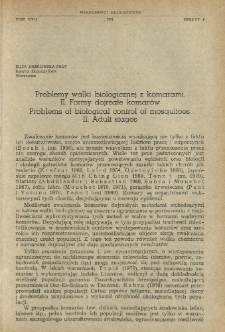- Search in all Repository
- Literature and maps
- Archeology
- Mills database
- Natural sciences
Advanced search
Advanced search
Advanced search
Advanced search
Advanced search

Object
Title: Problemy walki biologicznej z komarami. 2, Formy dojrzałe komarów
Subtitle:
Problems of biological control of mosquitoes. 2, Adult stages
Contributor:
Polska Akademia Nauk. Komitet Ekologiczny
Publisher:
Place of publishing:
Description:
Pages 353-366 ; 24 cm ; Bibliographical references (pages 362-365) ; Abstract in English ; 24 cm
Type of object:
Abstract:
The author discusses the difficulties involved in biological control of adult mosquitoes, arising mainly from the imposibility of defining centres of their occurence in habitats and their wide dispersal over a given area, which prevents a large part of the population being covered by control. There are two types of approach to the problems of the ecological control of mosquitoes over large areas by modyfications of the environment in such a way as to prevent dispersal flights and to concentrate the mosquitoes in defined habitats, making it difficult for tchem to reach humans. This method based on detailed analyses of the migratory phenomena of mosquitoes, was developed by Bek 1emisev (1949) and has been successfully applied in practice. Classic biological control of adult mosquitoes is based on utilization of population and biocenotic influences to reduce the abundance of mosquitoes in a habitat. In relation to population questions a discussion is given of methods of limiting the females' fecundity by radiological, chemical and genetic sterilization of males. In relation to biocenotic influences the author discusses the effects of predatory activities of different groups of animals (vertebrate and invertebrate) and of parasitism in limitation of the numbers of mosquitoes. Analysis of a large number of data showed, that biological control of mosquitoes produces successful result only in cases where there is disturbance of stabilisation of the biocenosis by the introduction of new predatory species, or change the habitat structure determrning the relationships between the prey and predator populations , for examples. A balanced biocenotic system usually maintains a relatively high level of numer of mosquitoes.
Relation:
Volume:
Issue:
Start page:
End page:
Detailed Resource Type:
Resource Identifier:
oai:rcin.org.pl:144347 ; ISSN 0013-2969
Source:
MiIZ PAN, call no. P.3259 ; click here to follow the link
Language:
Language of abstract:
Rights:
Creative Commons Attribution BY 3.0 PL license
Terms of use:
Copyright-protected material. [CC BY 3.0 PL] May be used within the scope specified in Creative Commons Attribution BY 3.0 PL license, full text available at: ; -
Digitizing institution:
Museum and Institute of Zoology of the Polish Academy of Sciences
Original in:
Library of the Museum and Institute of Zoology of the Polish Academy of Sciences
Projects co-financed by:
Access:
Object collections:
- Digital Repository of Scientific Institutes > Partners' collections > Museum and Institute of Zoology PAS > Scientific Journals
- Digital Repository of Scientific Institutes > Literature > Journals/Articles
Last modified:
Feb 4, 2025
In our library since:
Oct 26, 2020
Number of object content downloads / hits:
51
All available object's versions:
https://rcin.org.pl./publication/104327
Show description in RDF format:
Show description in RDFa format:
Show description in OAI-PMH format:
| Edition name | Date |
|---|---|
| Z. 4. Problemy walki biologicznej z komarami. 2, Formy dojrzałe komarów / Dąbrowska-Prot E. | Feb 4, 2025 |
Objects Similar
Dąbrowska-Prot, Eliza
Dąbrowska-Prot, Eliza
Dąbrowska-Prot, Eliza
Dąbrowska-Prot, Eliza
Dąbrowska-Prot, Eliza Łuczak, Jadwiga
Dąbrowska-Prot, Eliza Łuczak, Jadwiga Tarwid, Kazimierz

 INSTYTUT ARCHEOLOGII I ETNOLOGII POLSKIEJ AKADEMII NAUK
INSTYTUT ARCHEOLOGII I ETNOLOGII POLSKIEJ AKADEMII NAUK
 INSTYTUT BADAŃ LITERACKICH POLSKIEJ AKADEMII NAUK
INSTYTUT BADAŃ LITERACKICH POLSKIEJ AKADEMII NAUK
 INSTYTUT BADAWCZY LEŚNICTWA
INSTYTUT BADAWCZY LEŚNICTWA
 INSTYTUT BIOLOGII DOŚWIADCZALNEJ IM. MARCELEGO NENCKIEGO POLSKIEJ AKADEMII NAUK
INSTYTUT BIOLOGII DOŚWIADCZALNEJ IM. MARCELEGO NENCKIEGO POLSKIEJ AKADEMII NAUK
 INSTYTUT BIOLOGII SSAKÓW POLSKIEJ AKADEMII NAUK
INSTYTUT BIOLOGII SSAKÓW POLSKIEJ AKADEMII NAUK
 INSTYTUT CHEMII FIZYCZNEJ PAN
INSTYTUT CHEMII FIZYCZNEJ PAN
 INSTYTUT CHEMII ORGANICZNEJ PAN
INSTYTUT CHEMII ORGANICZNEJ PAN
 INSTYTUT FILOZOFII I SOCJOLOGII PAN
INSTYTUT FILOZOFII I SOCJOLOGII PAN
 INSTYTUT GEOGRAFII I PRZESTRZENNEGO ZAGOSPODAROWANIA PAN
INSTYTUT GEOGRAFII I PRZESTRZENNEGO ZAGOSPODAROWANIA PAN
 INSTYTUT HISTORII im. TADEUSZA MANTEUFFLA POLSKIEJ AKADEMII NAUK
INSTYTUT HISTORII im. TADEUSZA MANTEUFFLA POLSKIEJ AKADEMII NAUK
 INSTYTUT JĘZYKA POLSKIEGO POLSKIEJ AKADEMII NAUK
INSTYTUT JĘZYKA POLSKIEGO POLSKIEJ AKADEMII NAUK
 INSTYTUT MATEMATYCZNY PAN
INSTYTUT MATEMATYCZNY PAN
 INSTYTUT MEDYCYNY DOŚWIADCZALNEJ I KLINICZNEJ IM.MIROSŁAWA MOSSAKOWSKIEGO POLSKIEJ AKADEMII NAUK
INSTYTUT MEDYCYNY DOŚWIADCZALNEJ I KLINICZNEJ IM.MIROSŁAWA MOSSAKOWSKIEGO POLSKIEJ AKADEMII NAUK
 INSTYTUT PODSTAWOWYCH PROBLEMÓW TECHNIKI PAN
INSTYTUT PODSTAWOWYCH PROBLEMÓW TECHNIKI PAN
 INSTYTUT SLAWISTYKI PAN
INSTYTUT SLAWISTYKI PAN
 SIEĆ BADAWCZA ŁUKASIEWICZ - INSTYTUT TECHNOLOGII MATERIAŁÓW ELEKTRONICZNYCH
SIEĆ BADAWCZA ŁUKASIEWICZ - INSTYTUT TECHNOLOGII MATERIAŁÓW ELEKTRONICZNYCH
 MUZEUM I INSTYTUT ZOOLOGII POLSKIEJ AKADEMII NAUK
MUZEUM I INSTYTUT ZOOLOGII POLSKIEJ AKADEMII NAUK
 INSTYTUT BADAŃ SYSTEMOWYCH PAN
INSTYTUT BADAŃ SYSTEMOWYCH PAN
 INSTYTUT BOTANIKI IM. WŁADYSŁAWA SZAFERA POLSKIEJ AKADEMII NAUK
INSTYTUT BOTANIKI IM. WŁADYSŁAWA SZAFERA POLSKIEJ AKADEMII NAUK


































